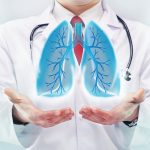Often, a thorough medical history and physical examination combined with a high-resolution CT scan can answer the diagnostic question, said Brett Elicker, MD, associate professor of radiology at UCSF. The high-resolution CT scan remains the modality of choice for detecting ILD in CTD and guiding future workups.
Speakers at the conference also presented a range of viewpoints on the risks and benefits of performing diagnostic lung biopsies in patients with CTD-ILD. “In the current era, we often do not perform a lung biopsy unless it’s going to impact treatment,” Dr. Fischer said. “Where I do recommend them is for idiopathic patients where you’re not clear on the etiology or in CTD patients with compelling concerns for an alternative cause, such as hypersensitivity pneumonitis.”

Harold Collard, MD
“I view surgical lung biopsy as a low-risk intervention—but not no risk,” added Harold Collard, MD, director of the ILD program at UCSF. He also highlighted alternate approaches to traditional video-assisted thoracoscopic surgery, including transbronchial cryobiopsy, which allows harvesting of up to 1 cm samples of tissue endoscopically.2
There are few research-supported treatments for many of the conditions under the CTD-ILD umbrella, Dr. Fischer said. Rheumatologists may look to scleroderma with lung involvement as a model for the treatment of other CTDs, because more is known about it. “I’m a rheumatologist—we often treat our patients with corticosteroids. But these are not good for the long term. So we look for steroid-sparing agents, as with any other rheumatologic condition.”
Rheumatologists also recommend immunosuppressive treatments for CTD-ILD conditions. One of those is cyclophosphamide, Dr. Fischer said. “If I use it, I use it short term and intravenously.” Other common treatments include azathioprine and mycophenolate mofetil, which has gained popularity as a potential glucocorticoid-sparing agent for the treatment of patients with a diverse spectrum of CTD-ILD.
Two drugs approved in recent years for the treatment of idiopathic pulmonary fibrosis, nintedanib, a tyrosine kinase inhibitor, and pirfenidone, an anti-fibrotic agent, are in various stages of clinical trial investigation for potential treatment of fibrotic ILD in CTD patients.
Non-Pharmaceutical Approaches

Jeffrey Golden, MD
For lung conditions that often cannot be cured—only managed or stabilized—non-pharmacologic treatments are an important component of comprehensive ILD care, Dr. Collard said. “The suffering of these patients cannot be overestimated. But non-pharmacologic interventions can positively impact how they feel.”
Pulmonary rehabilitation is a comprehensive intervention, based on a thorough patient assessment, that incorporates exercise and conditioning, education and behavioral change. Support groups are valued by ILD patients because they feel they are not so alone, with support from others who understand what they are going through.


